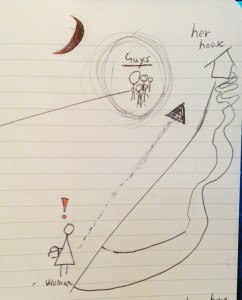Flin Nortier works as an interaction designer at Soda Studio. He visited MediaLAB to tell us about this, which resulted in an assignment which taught us how to take the feelings of the user into account.
Update of our concepts
Before explaining what we did during the workshop, the current state of our concepts has to be made clear. At the moment we are a bit lost, since none of our concepts seem to be fantastic. It feels like we need to look into another direction which is why Robbert Ritmeester (teacher Interactive Media at the HvA) came in to talk to us yesterday. He threw us back to the beginning of the process by looking at the assignment that CISCO gave us. At first, this was confusing, but then we understood that we should go back in order to get a new perspective. This is why at the moment we put our concepts in the fridge and have to think more about it in a different way. Robbert will come back to get us to the next step. During the interaction design workshop, we were supposed to use one of our concepts, but we could not do this.
What did we have to do during the workshop?
During the workshop, we were supposed to look at the core of one concept and think of one user scene. So, to take an example, the Cinekid team looked at the first time that a kid would use their game. The following process was considered when the user would use the product:
1.Moment
2.Response
3.Design solutions
We were supposed to first describe a moment in the process of using the product. Then we were to think of the emotional response of the user after which we had to think of design solutions.
What we really did
Moment
We could not use one of our concepts, since we need some new perspectives. That’s why Flin thought of the idea of considering the needs of a woman when she is in a certain situation. We thought of a woman walking home, but she has to pass a group of guys hanging around. What is her need at this moment?
Figure 1: A drawing of our user moment
Response
She doesn’t want to walk around them, because that would mean that she gives in. But it depends on her personality, because she might also choose to take another route. She would like to have someone else with her, so she feels more safe. She might also take into account that her stuff can be stolen, so she thinks of where she keeps her valuables. Some of us thought she would turn off her music, so she could hear what is happening, but others thought she would turn it on in order to get distracted. It can also be that she acts as if she doesn’t care that the guys are there, so they won’t bother her.
Design solutions
One way of making the women feel less scared we could have humor as a solution. We can also improve her confidence. But how can we do this? In order to put humour into the solution we could for example play a song, give the woman a silly walking assignment, make a weird noise or wear weird clothes (based on the story of Henriette van der Linden during which one of her friends went to New York all dressed up in a weird way so she wouldn’t be bothered by guys) Or to make her more confident, she can get the assignment to change her walking style, she could call someone, get to know the guys hanging around, start singing, or win a game.
What we learned
We did not come up with actual concepts, but it made us think about the problem all over again. It was useful to think of the needs of the woman in a specific situation. We thought of some different ideas like humor, which got us a little tiny bit further. We still need some sort of change in our way of thinking, so we don’t end up at the same kind of ideas. This was a step towards our different kind of thinking, but we need more help of Robbert to steer us in the right direction.






